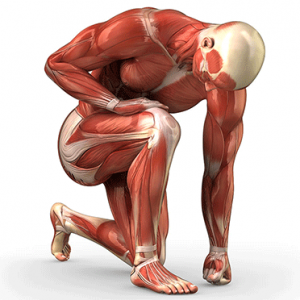
Over time, a tendon will develop tiny tears if put under too much pressure or strain. When a tendon tears often (small but regular tearing), it will cause Muscle Tendinitis. The pain from this injury will appear quickly and unexpectedly. Typically, tendon injuries occur in these three areas:
- musculotendinous junction (where the tendon joins the muscle)
- mid-tendon (non-insertional tendinopathy)
- tendon insertion (e.g. into bone)
Non-insertional tendinopathies start out as very small injuries (microtrauma) which worsen from repetitive overloading e.g. over-training.
Each person’s case is unique and we want to address your specific needs. If you would like us to investigate or provide some insight, we invite you to contact us by clicking the link below.
What is a tendon injury?
Tendons are tough fibers connecting muscle and bone. Most tendon injuries occur near joints, such as the shoulder, elbow, knee, and ankle. A tendon injury may mistakenly seem to appear quickly and unexpectedly, but in truth it happens over time. Health care professionals use different terms to describe a tendon injury. These include:
Tendinitis (or Tendonitis) means “inflammation of the tendon.” Inflammation is rarely the cause of tendon pain, but you will find many health care professionals using the term out of habit.
Tendinosis is a noninflammatory degenerative condition. The decline of collagen in the tendon is due to repeated strain under pressure (repetitive overloading). This is the most common form of tendinopathy.
Therefore, tendinopathies are best treated through functional rehabilitation compared to anti-inflammatory medication. Early diagnosis and intervention reduce the time it takes to heal and get you back to your normal routine.
What causes a tendon injury?
Most tendon injuries are the result of gradual wear and tear to the tendon from overuse or ageing. Anyone can have a tendon injury. People repeat the same motion (over and over) in their jobs, sports, or daily activities are more likely to damage a tendon.
Your tendons are designed to withstand high, repetitive loading, however, on occasions, when the load being applied to the tendon is too great for the tendon to withstand, the tendon begins to become stressed.
When tendons become stressed, they sustain small micro tears (otherwise known as lesions). These tears encourage inflammatory chemicals and swelling and heal quickly if managed appropriately.
However, if a load (pressure) is continually applied to a tendon, the tearing can be faster than the rate at which the tendon heals. The damage will progressively become worse, causing pain and dysfunction. The result is a tendinopathy or tendinosis.
Researchers suggest that tendinopathies start out as very small injuries (microtrauma), usually associated with physically intensive sport or leisure activities, which worsen over time to cause a tendinopathy.
What are the symptoms of tendinopathy?
Tendinopathy usually causes pain, stiffness, and loss of strength in the affected area.
- The pain may get worse when you use the tendon.
- You may have more pain and stiffness during the night or when you get up in the morning.
- The area may be tender, red, warm, or swollen if there is inflammation.
- You may notice a crunchy sound or feeling when you use the tendon.
The symptoms of a tendon injury can be a lot like those caused by bursitis.
Phases of tendinopathy
The inability of your tendon to adapt to the load quickly enough causes tendon to progress through four phases of tendon injury. While it is healthy for normal tissue adaptation during phase one, further progression can lead to tendon cell death and subsequent tendon rupture.
1. Reactive tendinopathy
- Normal tissue adaptation phase
- Prognosis: Excellent. Normal Recovery!
2. Tendon dysrepair
- Injury rate is more than the repair rate
- Prognosis: Good. Tissue is attempting to heal.
- It is vital that you prevent deterioration and progression to permanent cell death (phase 3).
3. Degenerative tendinopathy
- Cell death occurs
- Poor Prognosis – Tendon cells are giving up!
It is very important to have your tendinopathy professionally assessed to identify it’s injury phase. Identifying your tendinopathy phase is also vital to direct your most effective treatment, since certain modalities or exercises should only be applied or undertaken in specific tendon healing phases.
How is a tendon injury diagnosed?
To diagnose a tendon injury, your physiotherapist will ask questions about your past health, your symptoms and exercise regime. They’ll then do a physical examination to confirm the diagnosis. If your symptoms are severe or you do not improve with early treatment, specific diagnostic tests may be requested, such as an ultrasound scan or MRI.
How is tendinopathy treated?
In most cases, you can start treating a tendon injury at home. To get the best results, start these steps right away:
- Rest the painful area, and avoid any activity that makes the pain worse.
- Apply ice or cold packs for 20 minutes at a time, as often as 2 times an hour, for the first 72 hours. Keep using ice as long as it helps.
- Do gentle range-of-motion exercises and stretching to prevent stiffness.
- Have your biomechanics assessed by your physiotherapist.
- Undertake an Eccentric Strengthen Program. This is vital!

